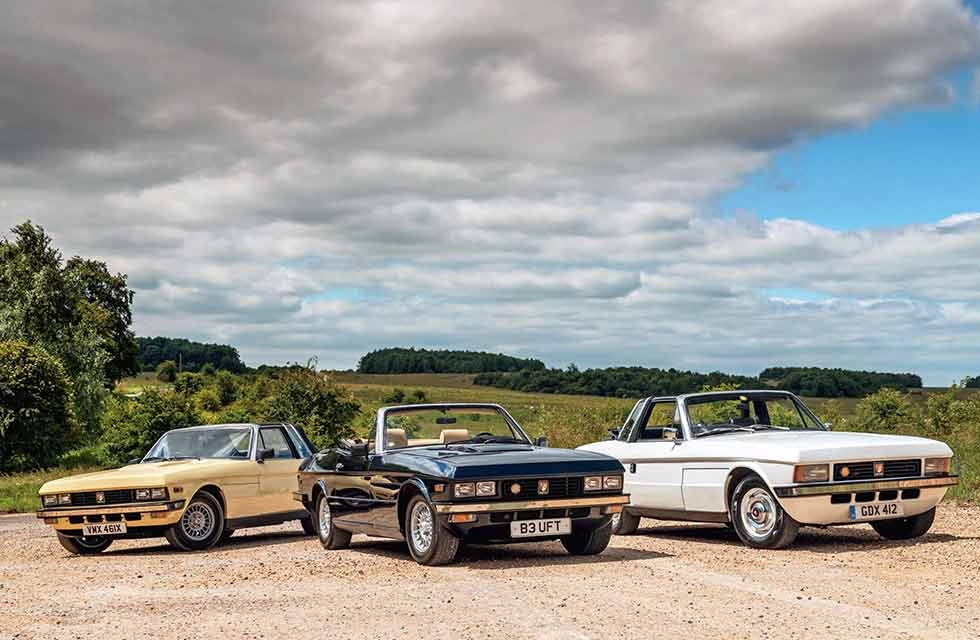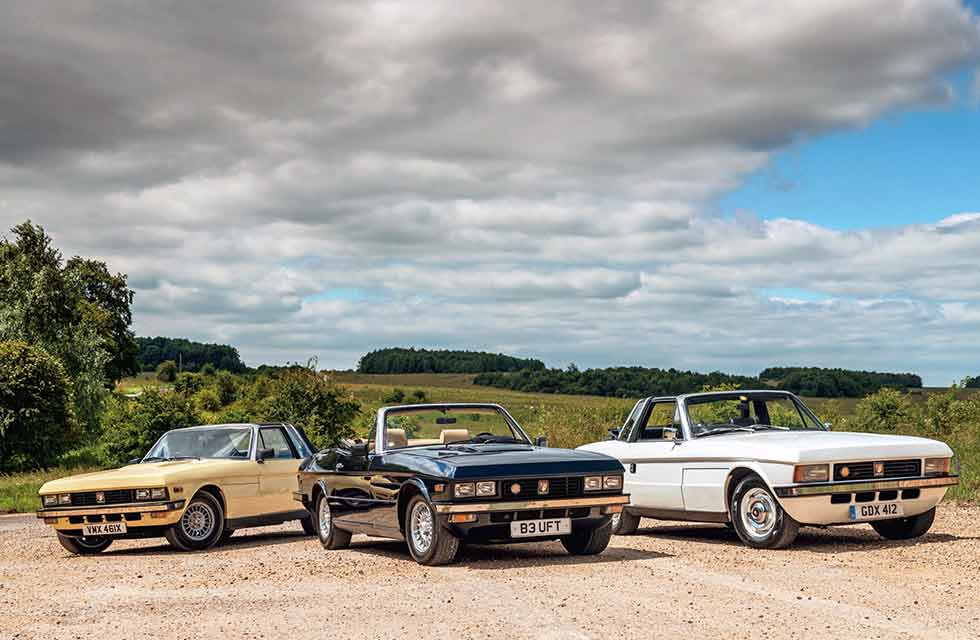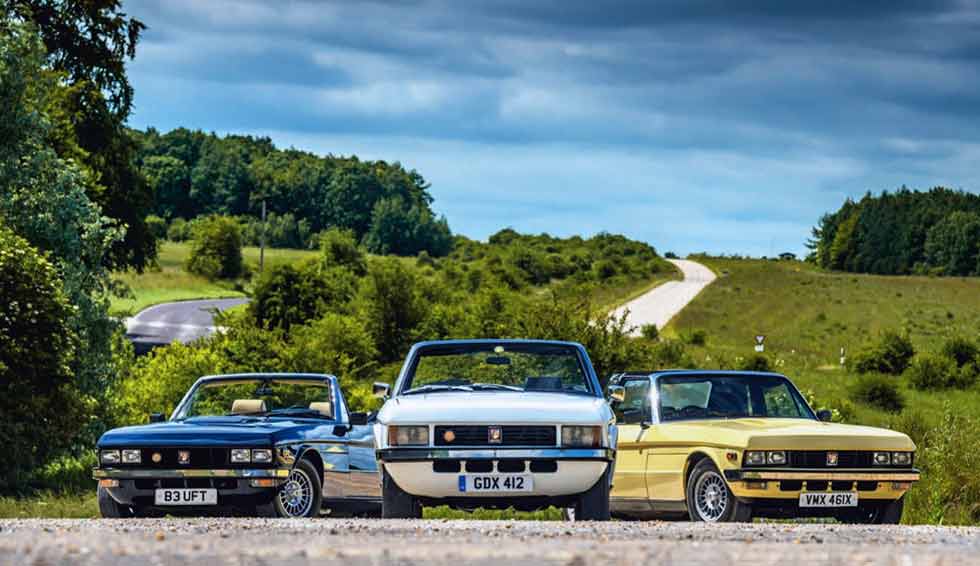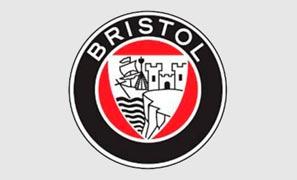
Tri-nation Turismo unfashionable Bristols. Martin Buckley praises the Zagato-styled 412, Beaufighter and unique Beaufort. Italian style, American power and a thoroughly British soul – so why are the Zagato Bristols so overlooked? Words Martin Buckley. Photography Olgun Kordal.
Early 1970s rumours about the Federal outlawing of convertibles on safety grounds turned out to be what we would now call ‘fake news’. Even so, it was enough to persuade American makers to stop offering softtop models after 1976, leaving the market open for more industrially nimble low-volume manufacturers to service a demand that was still very much alive, particularly among the affluent.

‘The 360º views the full convertible affords give the Beaufort a surprisingly different feel, but it is just as lively and rattle-free to drive as the 412’
Rolls-Royce’s Corniche was selling better than ever by the mid-’70s, with a waiting list stretching into years. Enter Jensen with its 1974 Interceptor Convertible, a hedonistic soft-top created to absorb buyers who were either too impatient to join the queue at Crewe or couldn’t justify the extra cash. Despite having no recent tradition of building drop-tops, Bristol Cars Ltd got the hint; a year later came the 412, a four-seater ‘convertible saloon’ styled by Zagato.
Both cars were Chrysler V8-powered statements of confidence in the future of big luxury cars after the gloom and despondency of the 1973-’1974 fuel crisis; misplaced confidence in the case of the Jensen, which died with the company in 1976 after just 267 cars. Not so the 412, which lived on in turbocharged Beaufighter form until 1992, although its lengthy production period does not equate to actual cars delivered. When sales got under way in 1976, Bristol boss Tony Crook let it be known that some 14 412s were under construction, and that he neither expected nor intended to build more than 70 a year, staying true to his long-held policy of never building more than three Bristols a week in the name of continued exclusivity.

In fact these open Bristols, the first since the 405 drophead of the mid-’50s, were destined to be a lot more exclusive than he intended or would ever have admitted. Just 20 Series 1 cars, 19 Series 2s, 19 turbocharged Beaufighters and a single Beaufort – an ‘export only’ full convertible, less roll-hoop – were built. Remarkably, however, thanks to Richard Hackett, former right-hand salesman to Crook, we have been able to assemble a full set of the controversial and still affordably priced 412 family.
The 412 was a rare departure from the one-model policy Crook had favoured since the early ’60s and, along with the 603 launched the following year, it raised awareness of a marque that normally shied away from publicity. Not since the arrival of Chrysler V8 power for the 1961 407 had a Bristol been released so freely for road testing by the specialist press. Selling steadily throughout the 1960s, regularly updated but never radically changed from one year to the next, the V8 Bristols simply got faster and more expensive until, by the end of the decade, the 411 was probably the most rapidly accelerating full four-seater car you could buy.
‘Long yet unfashionably narrow, the 412 was the most shockingly modern-looking Bristol since the 401’
Long yet unfashionably narrow, and with few entirely happy angles, the 412 was the most shockingly modern-looking Bristol since the 401, its rectangular headlamps, wraparound bumpers and square, flush-fitting doorhandles showing that Bristol was embracing the ’70s. Finished in modish burnt orange and sitting on Avon safety wheels, early 412s look surprisingly swish. For me, colour is everything with these cars: even a flattering hue fails to hide the difficulties of imposing modern, angular styling on the 1930s proportions that the Bristol’s famous box-section chassis dictated.
Inherited from the pre-war six-cylinder BMWs, and still sharing its 9ft 6in wheelbase with the 1947 Bristol 400, it was the product of 30 years of development, mostly under the single-minded guidance of Crook. During his stewardship at Filton (and later Patchway) there was never the money to make radical changes, so Crook made a virtue out of this venerable chassis’ inherent safety, both in terms of impact resistance and the essentially predictable handling of its impeccably located live rear axle, and the fact that the long-nosed proportions allowed room for those famous wing bays for the spare wheel and battery, liberating space in an already huge 22cu ft boot.
Throw in power steering that was the equal of anything available for its feel and feedback, hand-tooled quality that was heavily (if somewhat spuriously) aligned with the firm’s aerospace origins – ‘Bristol 412… from Concorde Country’ – and you can see why this 140mph four-seater still seemed to have a place in the world when we first saw it in the mid-’70s. Its flat, easy to form aluminium panels meant that Bristol could body the 412 in-house, rather than pay an expensive outside coachbuilder as was the case with the £2000 cheaper (and soon to die) 411. At nearly £15,000, the 412 was £4500 more than an Interceptor Convertible, but still £8000 less than a drop-top Corniche.
The Zagato styling of the 412 re-established Crook’s links with the Italian firm. He had been the UK concessionaire for Zagato, and was the driving force behind the 406 Zagatos of the early ’60s. The shape was inspired by Zagato’s Lancia Beta Spider of 1974 and attributed to chief stylist Giuseppe Mittino; he initially made it 2ft longer than Crook wanted due to a failure in communication. The front lights were Bosch and possibly shared with Opel; the rears were also found on the Lancia Spider, as was the general concept of a folding rear hood, welded steel rollbar and removable targa-style roof section over the front seats. Made in glassfibre on the production 412s, steel on the two Zagato-built prototypes, the panel could be stowed in the boot.
The first cars had frameless door glass that automatically dropped fractionally when the handle was pulled (a feature not seen on mainstream models until the ’90s). Later cars got a removable rear hardtop to augment the hood and make a fully weatherproof grand tourer.
Beneath the skin, the drivetrain was Chrysler’s F-series 6556cc V8 of undisclosed power. It was merely inspected by Bristol rather than modified, although the cam and ignition timing were set up by Filton technicians. The V8s were shipped in batches of 100, in unit with the Torqueflite automatic transmission, its partthrottle kickdown disabled by Bristol in this aluminium-bodied 3780lb (1715kg) two-door.
The Series 2 appeared in 1978 as a response to customers’ comments. It was fitted with framed doors and a smaller, lighter 5.9-litre V8; you can identify one by its ‘Bristol’ rather than Pegasus badges and headrests. The fact that the V8 ran on two-star did something to offset its thirst, as did cruise control and the option of LPG. Like most 412s, this white S2 is running Jaguar steel wheels with adapted ‘blazer button’ hubcaps.
Somewhat unkindly known as ‘The Fridge’ in Bristol circles, this four-time club concours winner has had an £80k restoration and must be the best of its ilk: very few 412s have had that sort of money lavished upon them. It might not be the ideal colour, but it’s a lovely car, fitted with the £600 factory air-conditioning system that Crook actively discouraged buyers from opting for because he felt the standard ventilation – designed by Concorde engineers – was so good.
Features such as the rails on the floor to keep the seatbelts tidy (always a problem in convertibles) show the kind of detail development that went into these cars, which were designed to be working vehicles rather than exotic toys.
This one has the optional, more supportive 603 seats, with plenty of space to keep tall drivers happy and enough room in the rear for full-sized humans – who get the use of no fewer than five ashtrays. Swathed in 261 pieces of Connolly hide, the 412 truly is ‘dignified travel for four people and their luggage’ and you can waft effortlessly along in ‘de Ville’ or ‘full targa’ mode, looking out along that snooker table-sized bonnet.
Far from glamorous to look at in its industrial shade of blue, the ‘360’ engine is set up for authoritative muscle rather than savage punch, with an exhaust note that suggests rather than asserts its eight cylinders with a remote burble. The silky automatic ’box, reassuringly positive power steering and strong, well-balanced brakes make it a relaxing car in which to cover ground. Stable in a straight line, it rolls quite a lot in corners, although the impression is probably heightened by the tall driving position. Whatever, it is a joy to push through long, open bends, with a lot of natural balance that makes it feel more neutral the faster you go, adding to that reassuring sense that the weight is low down.
The 1981 Beaufighter is largely more of the same, except that it adds scintillating urge into the equation. The earliest of these cars were delivered in 1980, making the quad-headlamp Beaufighter the first turbocharged British production car. It had a bulge in its bonnet to help accommodate the Rotomaster blower, mounted on the right-hand exhaust manifold with a wastegate on the crossover pipe.
At low speeds the Beaufighter has the same mild manners as the naturally aspirated car, thanks to a priority valve that allows the mixture to bypass the turbo at light throttle openings. Press harder – the pedal has a particularly pleasing feel – and the pressure disparity between the manifold and the Carter four-barrel carburettor equalises, gradually closing the priority valve and putting mixture straight into the compressor as the car surges away in one thrilling, seamless bound of solid thrust that gets stronger just as you think it’s about to tail off.
The additional (also undisclosed) power is well matched to the change-up points of the Torqueflite so that dignity is always maintained. Self-levelling rear suspension plays its part in this and the live axle, sprung by torsion bars and restrained by a Watt linkage, only betrays itself with the occasional twitch on mid-corner bumps. The Beaufighter was more firmly set up than the 412 from the factory, but the difference feels marginal here (you could have your adjustable dampers set to taste in any case).
With its remote boot release, electric mirrors and central locking, the Beaufighter shows how Crook and his faithful team at Concorde Road, Patchway, were keeping their cars abreast of ’80s developments in labour-saving luxuries. The Beaufort is a postscript to the 412 story, a fully open car without the rollbar and fitted with a powered top. Destined to be a one-off, it was created at Crook’s instigation as a way of getting a foothold in the US market – hence left-hand-drive – but was a serious enough idea to warrant printing a brochure. Built in 1984, but not registered until ’88, the Beaufort’s first owner was Crook himself, who later commented that the hood rams took up too much rear-seat space, which was why the project was abandoned.
Originally finished in cream, the Beaufort was later bought by an Egyptian businessman who, due to illness, abandoned it in a hotel car park in London. It slipped into the used-car trade for a while but has since re-emerged in a much more fetching shade of Aston Martin Midnight Blue. While later Beaufighters had a flat dash panel, the Beaufort retains the classic seven-dial binnacle with cream leather seats piped in blue.
Hood down, the Beaufort loses the 412’s quirky charm. Hood up it verges on being quite handsome, but the compromised rear vision and back-seat space make it less practical. The power top works unobtrusively and looks neat when stowed. The 360º views it affords give the Beaufort a surprisingly different feel, but essentially it is as lively and rattle-free to drive as the 412.
If the 411 was almost self-consciously sober, the 412 was Bristol’s first attempt to build a more flamboyant offering, a car in the mould of the Rolls-Royce Camargue and the soon-to-emerge William Towns Lagonda. Bold and sharp-edged, the 412 didn’t seek to fade into the background but was a ‘statement’ motor car in the ’70s idiom. They have grown on me over the years and, while they are still an acquired taste (reflected in surprisingly realistic prices for such a rarity), the passage of time may eventually allow these eccentric cars to have their day. As of now, as a Zagato-styled, Chrysler-powered statement of luxuriously practical open-top British individualism, there is nothing to touch them.
Thanks to SLJ Hackett (01985 219551; www.sljhackett.co.uk)
The 412 family remains an acquired taste, but few handbuilt exotics are more affordable. Above: the Beaufort shares the 412 dashboard, with braided glovebox handle; lighter, more compact V8 helped balance; unique badge.
BRISTOL 412/BEAUFIGHTER
Sold/no built 1975-’1992/59 (inc Beaufort)
Construction steel chassis, aluminium body
Engine all-iron, ohv 6556/5898cc V8, with Carter four-barrel carburettor (Rotomaster turbocharger on Beaufighter)
Max power not disclosed
Max torque not disclosed
Transmission three-speed automatic, RWD
Suspension: front independent by double wishbones, coil springs, anti-roll bar rear live axle, torsion bars, Watt linkage; telescopic dampers f/r Steering ZF recirculating ball
Brakes discs
Length 16ft 2 ½ in (4940mm)
Width 5ft 9 ¾ in (1770mm)
Height 4ft 8 ½ in (1435mm)
Wheelbase 9ft 6in (2896mm)
Weight 3780Ib (1715kg)
0-60mph 7.9 secs (412)
Top speed 140mph
Mpg 13-15
Price new £14,584
Price now £20-60,000+
All three roll, but grip well and have impressive poise. Above, left to right: turbo gives the Beaufighter huge pace; simpler instrument binnacle; Britain’s first production turbo. Top: later car chases white 412 and fully open Beaufort.
Clockwise from main: cabin is luxurious but avoids being ostentatious; huge Chrysler V8 offers plenty of muscle; generous rear space means that the 412 is a full four-seater; quirky semi-circular cutout in angular bootlid panel.






